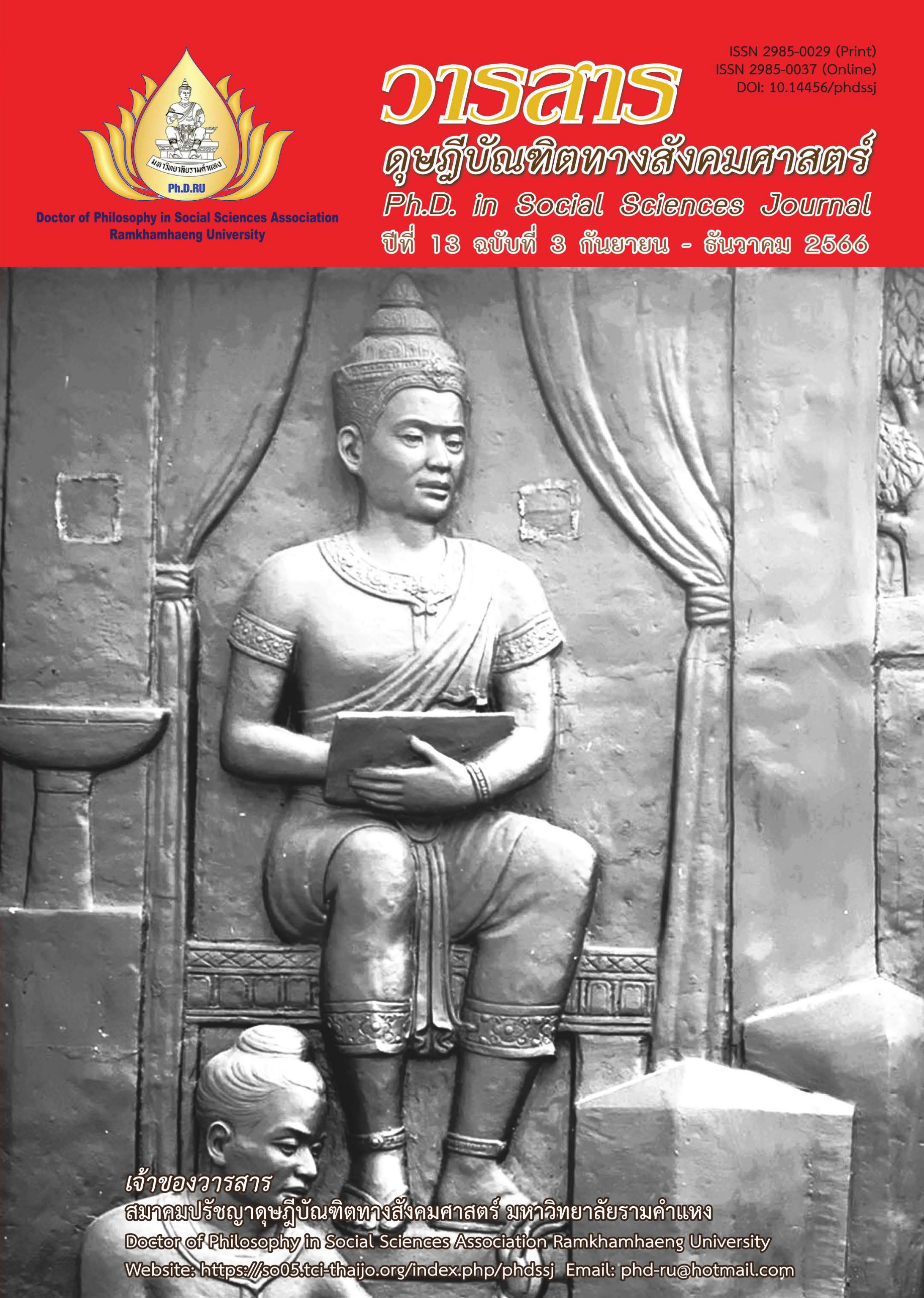The Analysis of the Effect on the Government Expenditure Under the 12th National and Social Development Plan with Dynamic Stochastic General Equilibrium
Main Article Content
Abstract
This research article aims to (1) study changes of the economic multiplier from the use of government fiscal measures, using a dynamic stochastic general equilibrium model, and (2) analyze the choice of appropriate fiscal measures from the changes of the economic multiplier for stimulate aggregate demand during the 12th National Economic and Social Development Plan of Thailand. The DSGE model was used to examine the data in this study, analyzing secondary data collected from relevant government agencies' online databases between 2017 and 2021, using the DSGE-NK model and Bayesian parameter estimation.
Findings are as follows: The reduction of personal income and corporate taxes is the most effective fiscal measure to intensify household consumption and private investment multipliers in the short, medium, and long run. Thus, the government and relevant agencies should consider reducing personal income and consumption taxes to boost the economy's aggregate demand.
Article Details

This work is licensed under a Creative Commons Attribution-NonCommercial-NoDerivatives 4.0 International License.
Academic articles, research articles, and book reviews in the Ph.D. in Social Sciences Journal are author’s opinions, and not the publisher’s, and is not the responsibility of the Ph.D. in Social Sciences Journal Philosophy Association, Ramkhamhaeng University. (In the case that research is done on human, the researcher has to be trained in Ethics for Doing Research on Human Training and has to produce the evidence of the training).
References
Alesina, A., & Ardagna, S. (2010). Large changes in fiscal policy: Taxes versus spending. Tax Policy and the Economy, 24(1), 35-68.
Arnold, J. M., Brys, B., Heady, C., Johansson, A., Schwellnus, C., & Vartia, L. (2011). Tax policy for economic recovery and growth. The Economic Journal, 121(550), 59-80.
Bastian, J. E., & Jones, M. R. (2021). Do EITC expansions pay for themselves?: Effects on tax revenue and government transfers. Journal of Public Economics, 196(1), 104355.
Batini, N., Eyraud, L., & Weber, A. (2014). A simple method to compute fiscal multipliers. Retrieved from https://www.imf.org/external/pubs/ft/wp/2014/wp1493.pdf
Bawono, I. R., Halim, A., & Lord, B. (2012). Public sector performance measurement and budget allocation: An Indonesian experiment. Retrieved from https://ir.canterbury.ac.nz/bitstreams/e1e338a0-0d72-495e-b670-077589005a80/download
Blanchard, O. J., & Kiyotaki, N. (1987). Monopolistic competition and effects of aggregate demand. The American Economic Review, 77(4), 647-666.
Christiano, L., Eichenbaum, M., & Rebelo, S. (2011). When is the government spending?: Multiplier large. The Journal of Political Economy, 119(1), 78-121.
Christofzik, D. I., Fuest, A., & Jessen, R. (2022). Macroeconomic effects of the anticipation and implementation of tax changes in Germany: Evidence from a narrative account. Economica, 89(353), 62-81.
Coenen, G., Straub, R., & Trabandt, M. (2013). Gauging the effects of fiscal stimulus packages in the euro area. Journal of Economic Dynamics and Control, 37(2), 367-386.
Crul, M., Schneider, J., Keskiner, E., & Lelie, F. (2017). The multiplier effect: How the accumulation of cultural and social capital explains steep upward social mobility of children of low-educated immigrants. Ethnic and Racial Studies, 40(2), 321-338.
Delong, J. B., & Summers, L. H. (2012). Fiscal policy in a depressed economy. Brookings Papers on Economic Activity, 43(1), 233-297.
Drautzburg, T., & Uhlig, H. (2015). Fiscal stimulus and distortionary taxation. Review of Economic Dynamics, 18(4), 894-920.
Dudzevičiute, G., Šimelyte, A., & Liučvaitiene, A. (2018). Government expenditure and economic growth in the European union countries. International Journal of Social Economics, 45(2), 372-386.
Eggertsson, G. B. (2011). What fiscal policy is effective at zero interest rates?. NBER Macroeconomics Annual, 25(1), 59-112.
Gale, W. G., & Samwick, A. A. (2017). Effects of income tax changes on economic growth. In A. J. Auerbach & K. Smetters (Eds.). The economics of tax policy (pp. 13-39). Oxford University Press.
Gil, P., Martí, F., Morris, R., Pérez, J. J., & Ramos, R. (2019). The output effects of tax changes: Narrative evidence from Spain. SERIEs, 10(1), 1-23.
Harding, A. (2018). The effect of government transfer programs on low-income rates: A gender-based analysis, 1995 to 2016. Retrieved from https://epe.lac-bac.gc.ca/100/201/301/weekly_acquisitions_list-ef/2018/18-45/publications.gc.ca/collections/collection_2018/statcan/75f0002m2018003-eng.pdf
Kim, W. (2021). Macroeconomic effects of government transfer payments: Evidence from Korea. Economic Modelling, 102, 1-25.
López-Salido, J. D., & Rabanal, P. (2006). Government spending and consumption-hours preferences. Federal Reserve Bank.
Lucas, Jr., R. E. (1976). Econometric policy evaluation: A critique. In Carnegie-Rochester conference series on public policy (vol. 1, pp. 19-46). North-Holland.
Maipita, I. (2012). Simulasi pengeluaran pemerintah dan dampaknya terhadap kinerja ekonomimakro: Suatu model computable general equilibrium. Quantitative Economics Journal, 1(2), 1-15.
Munir, K., & Riaz, N. (2020). Macroeconomic effects of exogenous fiscal policy shocks in Germany: A disaggregated SVAR analysis. Revista Hacienda Publica Espanola, 233(2), 141-165.
National Statistical Office. (2022). Necessary statistical information for the region and province. Author. [In Thai]
Ono, Y. (2011). The Keynesian multiplier effect reconsidered. Journal of Money, Credit and Banking, 43(4), 787-794.
Ramsey, F. P. (1927). A contribution to the theory of taxation. Economic Journal, 37(145), 47-61.
Rotemberg, J. J. (1982). Sticky prices in the United States. Journal of Political Economy, 90(6), 1187-1211.
Shen, M. W., Yang, M. S. S., & Zanna, L. F. (2015). Government spending effects in low-income countries. International Monetary Fund.
Smets, F., & Wouters, R. (2003). An estimated dynamic stochastic general equilibrium model of the Euro area. Journal of the European Economic Association, 1(5), 1123-1175.
Sujianto, A. E., & Azmi, M. F. U. (2020). Associative study on government spending, inflation, trade balance, and gross domestic product. Ekuilibrium Jurnal Ilmiah Bidang Ilmu Ekonomi, 15(1), 27-37.
van der Wielen, W. (2020). The macroeconomic effects of tax changes: Evidence using real-time data for the European union. Economic Modelling, 90(1), 302-321.
Wu, S. Y., Tang, J. H., & Lin, E. S. (2010). The impact of government expenditure on economic growth: How sensitive to the level of development?. Journal of Policy Modeling, 32(6), 804-817.


